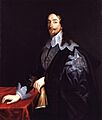Court of High Commission facts for kids
The Court of High Commission was a very powerful court in England. It was the top court for church matters. King Henry VIII started it in 1534. It lasted until 1689, but it was closed for a time in 1641. This happened when Parliament decided to get rid of it.
John Whitgift, who was the Archbishop of Canterbury, helped the court get more power in the 1580s. He even helped pass a law that made being a Puritan a crime. The court was most powerful during the time of the English Reformation. It was finally closed by Parliament in 1641. The king or queen could call the court whenever they wanted. It had huge power over both church and everyday issues. There were also similar courts in Scotland. The court briefly returned under King James II in 1686. But it was permanently closed by the Bill of Rights in 1689.
Contents
How the Court Worked Under Elizabeth I
During the time of Elizabeth I, the Court of High Commission became even more important. It started handling more appeals. This was because people in England were taking more disputes to court.
The Act of Supremacy
Soon after Elizabeth I became queen, the Act of Supremacy was passed. This law combined the powers of regular courts and church courts. It gave the Queen the right to prosecute people. Parliament agreed to this new power. This meant the Queen could use her authority to deal with both public and private matters.
The Ex Officio Oath
The court used a special method called the ex officio mero oath. This meant a judge could start a case on their own. They did not need someone else to make a formal accusation. The judge would make the accused person swear an oath. Then, the judge would decide if the person was guilty or innocent.
When King James became king, Puritans worried about this oath. They also worried about people being held before trial. And they disliked that the court did not use juries. Some people felt the court was taking on too much power. They thought it was handling cases that should have gone to regular courts.
Court Cases and Decisions
The Court of High Commission also dealt with marriage issues. It could even decide if couples should live apart. For example, in 1566, the court allowed a couple to live separately for a "cooling off period." If a wife refused to go back to her husband, the court might take away her church rights. When the court ordered separations, it sometimes made the husband pay money to the wife. This was like alimony today. However, the court did not often do this. It was only done when it was the most practical solution. The court did not create new ways for people to get divorced or permanently separated.
Why the Court Was Closed
The Court of High Commission was officially closed by the Triennial Act. This law was passed by Parliament in 1641. The Triennial Act made sure that the King had to call Parliament together every three years.
The Role of Archbishop Laud
The Act also led to the removal of Archbishop William Laud. King Charles I had supported Laud. Laud's new ideas and prayers made many people, especially in Scotland, very upset. When King Charles I asked Parliament for an army, they refused. They did not trust him. So, the King decided to create his own army. This disagreement was one of the reasons that led to the English Civil War.
Images for kids
-
John Whitgift, Archbishop of Canterbury




